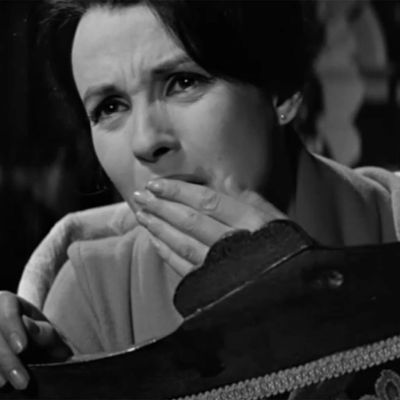
Fifty-five years before Mike Flanagan would reimagine Shirley Jackson’s novel The Haunting of Hill House for Netflix, there was Robert Wise’s adaptation The Haunting. A mostly faithful adaptation, The Haunting amassed a large following and was formative for filmmakers like Steven Spielberg and Martin Scorsese, who named the film one of the scariest of all time. Though Jackson’s source material provided a solid foundation of fear, it was the way in which Wise crafted the scares and atmosphere that gave The Haunting such an enduring quality. Very few scenes in horror are as memorable or as terrifying as this one, which made our list of the 100 Scares That Shaped Horror: Eleanor “Nell” Lance (Julie Harris) cowers in fear with Theo (Claire Bloom) as an unseen presence bangs relentlessly on their bedroom door, the sounds growing louder and the door bending inward with force.
Wise was in postproduction on musical classic West Side Story when he read Jackson’s novel. He was petrified, therefore immediately interested in producing a feature adaptation, so he passed it on to his longtime collaborator Nelson Gidding to pen the screenplay. The basic premise of Jackson’s novel sees a group of four spending the night at Hill House in hopes of finding scientific evidence of the supernatural, but Gidding was convinced it was a novel about Nell’s mental deterioration and wove the psychological element into the screenplay. It was this layer of mania combined with the way Wise shot and edited the film that elicited pure terror.
Prior to the Academy Award–winning West Side Story, Wise already had a lengthy list of notable credits under his belt. He began his film career as a sound and music editor — a vital skill that would later serve him well in the genre. From there, his interests shifted into film editing; he was even nominated for an Academy Award for Best Film Editing on Citizen Kane in 1941. Wise’s transition into directing came with the 1944 horror film The Curse of the Cat People, when the studio handed the reins over to him after original director Gunther von Fritsch fell far behind schedule. Producer Val Lewton, an influential horror director responsible for crafting the “Lewton Bus” scare technique, praised his work to studio superiors, which led to further horror collaborations between Lewton and Wise.
By the time he fell for Jackson’s novel, Wise knew how to connect with the viewer — something he considered the most vital component of filmmaking. In the case of The Haunting, this meant evoking a consistent state of horror. To do that, he used clever editing and camerawork. Nell was often viewed from overhead, and her viewpoint would coincide with creepy shots of Hill House. Rapid cuts and off-kilter angles maintained a sense of unease. This style culminated in the iconic scare in Nell and Theo’s bedroom. The bedroom door itself was made of laminated wood; the bending was a result of a crew member shoving a piece of lumber against it. It was then made terrifying by Wise filming it from a very low to the ground angle, with rapid zooms into the door knob timed to every banging sound. Wise then intercut this with rapid edits, weaving in multiple angles of the room and the actors’ terrified reactions. The aim was to disorient, inducing fear as a by-product. It’s by all means a simple moment, but what makes it so brilliant is how Wise found a way to use the camera to represent Nell’s thoughts and fears. Every bit of it is felt in that moment that the presence bangs, pounds, and rails against that door.

